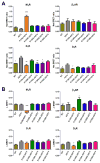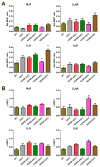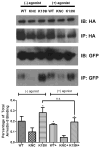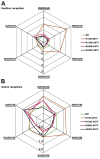Differential manipulation of arrestin-3 binding to basal and agonist-activated G protein-coupled receptors
- PMID: 28461104
- PMCID: PMC5797668
- DOI: 10.1016/j.cellsig.2017.04.021
Differential manipulation of arrestin-3 binding to basal and agonist-activated G protein-coupled receptors
Abstract
Non-visual arrestins interact with hundreds of different G protein-coupled receptors (GPCRs). Here we show that by introducing mutations into elements that directly bind receptors, the specificity of arrestin-3 can be altered. Several mutations in the two parts of the central "crest" of the arrestin molecule, middle-loop and C-loop, enhanced or reduced arrestin-3 interactions with several GPCRs in receptor subtype and functional state-specific manner. For example, the Lys139Ile substitution in the middle-loop dramatically enhanced the binding to inactive M2 muscarinic receptor, so that agonist activation of the M2 did not further increase arrestin-3 binding. Thus, the Lys139Ile mutation made arrestin-3 essentially an activation-independent binding partner of M2, whereas its interactions with other receptors, including the β2-adrenergic receptor and the D1 and D2 dopamine receptors, retained normal activation dependence. In contrast, the Ala248Val mutation enhanced agonist-induced arrestin-3 binding to the β2-adrenergic and D2 dopamine receptors, while reducing its interaction with the D1 dopamine receptor. These mutations represent the first example of altering arrestin specificity via enhancement of the arrestin-receptor interactions rather than selective reduction of the binding to certain subtypes.
Keywords: Arrestin; GPCRs; Protein engineering; Protein-protein interactions; Receptor specificity.
Copyright © 2017. Published by Elsevier Inc.
Figures







Similar articles
-
Role of receptor-attached phosphates in binding of visual and non-visual arrestins to G protein-coupled receptors.J Biol Chem. 2012 Mar 16;287(12):9028-40. doi: 10.1074/jbc.M111.311803. Epub 2012 Jan 24. J Biol Chem. 2012. PMID: 22275358 Free PMC article.
-
Critical role of the finger loop in arrestin binding to the receptors.PLoS One. 2019 Mar 15;14(3):e0213792. doi: 10.1371/journal.pone.0213792. eCollection 2019. PLoS One. 2019. PMID: 30875392 Free PMC article.
-
A beta-arrestin binding determinant common to the second intracellular loops of rhodopsin family G protein-coupled receptors.J Biol Chem. 2006 Feb 3;281(5):2932-8. doi: 10.1074/jbc.M508074200. Epub 2005 Nov 30. J Biol Chem. 2006. PMID: 16319069
-
Receptor-Arrestin Interactions: The GPCR Perspective.Biomolecules. 2021 Feb 4;11(2):218. doi: 10.3390/biom11020218. Biomolecules. 2021. PMID: 33557162 Free PMC article. Review.
-
Beta-arrestin signaling and regulation of transcription.J Cell Sci. 2007 Jan 15;120(Pt 2):213-8. doi: 10.1242/jcs.03338. J Cell Sci. 2007. PMID: 17215450 Review.
Cited by
-
GPCR Signaling Regulation: The Role of GRKs and Arrestins.Front Pharmacol. 2019 Feb 19;10:125. doi: 10.3389/fphar.2019.00125. eCollection 2019. Front Pharmacol. 2019. PMID: 30837883 Free PMC article. Review.
-
The structural basis of the arrestin binding to GPCRs.Mol Cell Endocrinol. 2019 Mar 15;484:34-41. doi: 10.1016/j.mce.2019.01.019. Epub 2019 Jan 28. Mol Cell Endocrinol. 2019. PMID: 30703488 Free PMC article. Review.
-
Arrestin-mediated signaling: Is there a controversy?World J Biol Chem. 2018 Dec 12;9(3):25-35. doi: 10.4331/wjbc.v9.i3.25. World J Biol Chem. 2018. PMID: 30595812 Free PMC article. Review.
-
Targeting arrestin interactions with its partners for therapeutic purposes.Adv Protein Chem Struct Biol. 2020;121:169-197. doi: 10.1016/bs.apcsb.2019.11.011. Epub 2019 Dec 18. Adv Protein Chem Struct Biol. 2020. PMID: 32312421 Free PMC article. Review.
-
Arrestins: Introducing Signaling Bias Into Multifunctional Proteins.Prog Mol Biol Transl Sci. 2018;160:47-61. doi: 10.1016/bs.pmbts.2018.07.007. Epub 2018 Sep 6. Prog Mol Biol Transl Sci. 2018. PMID: 30470292 Free PMC article. Review.
References
-
- Schoneberg T, Schulz A, Biebermann H, Hermsdorf T, Rompler H, Sangkuhl K. Pharmacol Ther. 2004;104:173–206. - PubMed
-
- Russo D, Arturi F, Schlumberger M, Caillou B, Monier R, Filetti S, Suarez HG. Oncogene. 1995;11:1907–1911. - PubMed
-
- Hebrant A, van Staveren WC, Maenhaut C, Dumont JE, Leclere J. Eur J Endocrinol. 2011;164:1–9. - PubMed
-
- Carman CV, Benovic JL. Curr Opin Neurobiol. 1998;8:335–344. - PubMed
MeSH terms
Substances
Grants and funding
LinkOut - more resources
Full Text Sources
Other Literature Sources
Molecular Biology Databases

